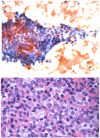The Role of Molecular Testing for the Indeterminate Thyroid FNA
- PMID: 31547603
- PMCID: PMC6826845
- DOI: 10.3390/genes10100736
The Role of Molecular Testing for the Indeterminate Thyroid FNA
Abstract
Thyroid nodules are common in the adult population where a majority are benign and only 4.0% to 6.5% are malignant. Fine needle aspiration (FNA) is a key method used in the early stages to evaluate and triage patients with thyroid nodules. While a definitive cytological diagnosis is provided in more than 70-75% of all thyroid FNA cases, the group of indeterminate lesions offers a challenge in terms of interpretation and clinical management. Molecular testing platforms have been developed, are recognized as an option by the 2015 American Thyroid Association Guidelines, and are frequently used in conjunction with FNA as an integral part of the cytologic evaluation. In this review, the utility of molecular testing options for nodules assigned to the group of indeterminate thyroid FNAs is described.
Keywords: cytology; fine needle aspiration; molecular testing; personalized medicine; thyroid cancers.
Conflict of interest statement
The authors declare no conflict of interest.
Figures





References
-
- Broome J.T., Solorzano C.C. The impact of atypia/follicular lesion of undetermined significance on the rate of malignancy in thyroid fine-needle aspiration: Evaluation of the Bethesda System for Reporting Thyroid Cytopathology. Surgery. 2011;150:1234–1241. doi: 10.1016/j.surg.2011.09.006. - DOI - PubMed
Publication types
MeSH terms
Grants and funding
LinkOut - more resources
Full Text Sources
Medical

